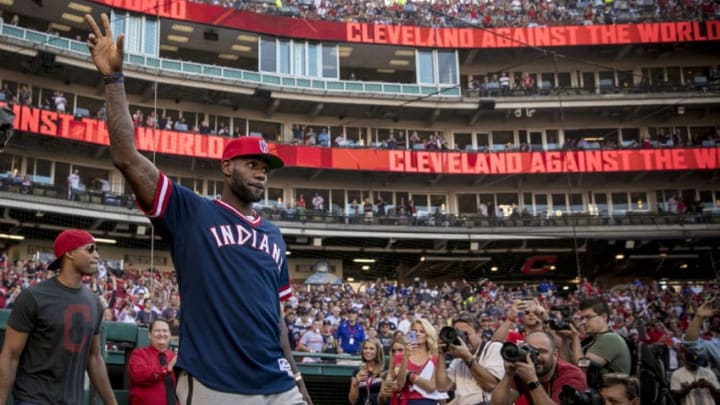
Cleveland Indians’ philosophy: Always keep an eye on the future
For the Cleveland Indians, it has been a relatively bumpy ride for them since their two trips to the World Series in 1995 and 1997. Even worse, since 2001, the Indians only made the playoffs three times (2007,2013 and 2016.)
One of, if not the biggest reason for their lack of success throughout the last 20 years, is how the MLB is set up. Unlike the NBA there is no salary cap. Each team has their own payroll and typically the teams located in larger markets (Los Angeles, New York, Boston, Chicago) have the highest payrolls.
Cleveland, who is considered a small-market team, usually ranked in the bottom third of baseball in terms of payroll. From 2011-2016 the Indians never ranked higher than 22nd in terms of payroll. While they still were able to field decent teams, they never had any realistic hope of making a deep run in the postseason.
They were simply at a disadvantage.
More from King James Gospel
- Cavaliers’ Darius Garland should continue to improve in this area
- Top five Cleveland Cavaliers role players of all-time
- 3 possible starting lineups for Cleveland Cavaliers in 2023-24
- The Cavaliers may have snagged a hidden gem in Craig Porter Jr.
- 4 players the Cavaliers should pursue in 2024 free agency
Major League Baseball tries to solve this revenue problem by putting a system in place within their collective bargaining agreement which is called revenue sharing. With revenue sharing, MLB redistributes money made during the season away from teams with the higher payrolls and gives more to the teams at the bottom of the payroll rankings.
But even with this help from the collective bargaining agreement, teams that find themselves at the bottom of the payroll list still have little chance to succeed long term.
Here is an excerpt from a 2012 article in the Northwestern Business Review titled: Why Certain MLB Teams Can Afford Star Players and Others Cannot. This explains how much of an advantage teams with higher payrolls truly have.
"But does this payroll gap really matter? Recently, CNBC’s sports business journalist (and Northwestern alum) Darren Rovell reported a study focusing on this very issue. During the period from 2001–2010, 61.5% of the league’s playoff teams were among the top 10 biggest spenders; 23.1% ranked 11th-20th in total end of the year payroll and 15.4% were among the league’s poorest 10 teams. The evidence is clear: teams in the top third in overall payroll have almost twice the chance of reaching the playoffs than other teams."
So smaller market teams like the Indians have to be diligent when it comes to how they build their team. Drafting well is a key and developing their talent in their farm system is also vital in putting together a winning team in a small market.
Throughout the last decade, the Indians have focused primarily on the draft and their farm system and built from within.
Now because of the way the Indians chose to build their team, they have their core group of players all on team-friendly deals and are not financially strapped in the long run.
The building process for the Tribe all came to a head last year when the Indians saw their opportunity at competing for a championship and did what many thought they would not do, went for it.
In late July of last year the Indians were 60-42 and were running away with their division, but still needed help if they wanted to make a deep run in the postseason.
The Dolans, along with the Indians front office rolled the dice and gave up two of their top prospects for reliever Andrew Miller at the trade deadline. Bringing in Miller meant taking on his $9 million dollar per year contract for the next 2.5 seasons.
BREAKING: Andrew Miller to #Indians.
— Ken Rosenthal (@Ken_Rosenthal) July 31, 2016
For once, money was not a deal-breaker for the Indians in a trade. The fan base was both shocked and surprised. Miller was nothing short of spectacular for the Indians, fooling seemingly every batter he faced once he stepped on the mound for Cleveland.
Once the team set foot in the playoffs, all parts of the 25 man roster clicked at the right time and lost just one game on their way to the World Series. Even after a crushing Game 7 loss to the Chicago Cubs, there was still hope that the Indians would come back in 2017 and do it all over again.
From their deep run in October last season, the franchise made nearly $50 million dollars. This allowed the Indians to then sign coveted free agent Edwin Encarnacion last December. The deal for Encarnacion was a record one for the Indians, signing him to a three-year, $60 million contract.
Fast forward to just a couple weeks ago, the Indians actually outbid the New York Yankees (yes you are reading that right) and essentially won the right to trade for outfielder Jay Bruce.
The main reason why the Indians got him over the Yankees was the willingness of Indians ownership to pay Bruce’s full contract for the rest of the year. Bruce’s addition to the team gives them one more potent hitter in an already stacked lineup.
This move again made a loud statement, the Indians recognized this was their time and they were going all in for a title.
Now the Indians currently sit in first place again in their division, with a record of 68-54 and are ready to once again run away with first place.
Unlike the Cavaliers, the Indians were much more cautious with their money, but by taking their time and waiting for the right moves, they are set up to be one of baseball’s best teams for the next few years.
